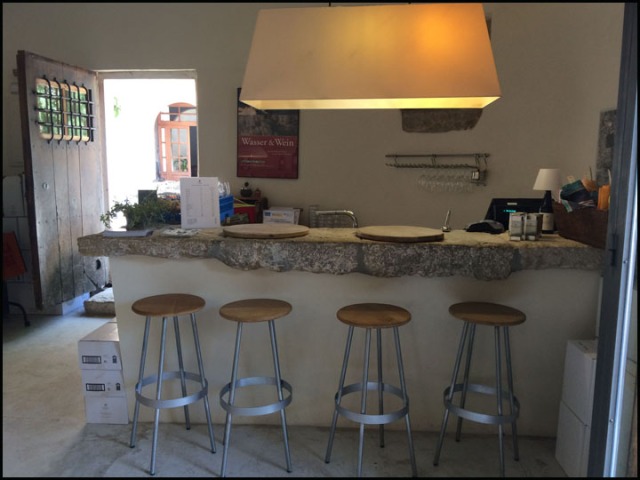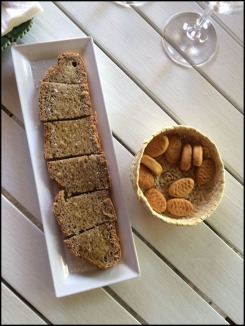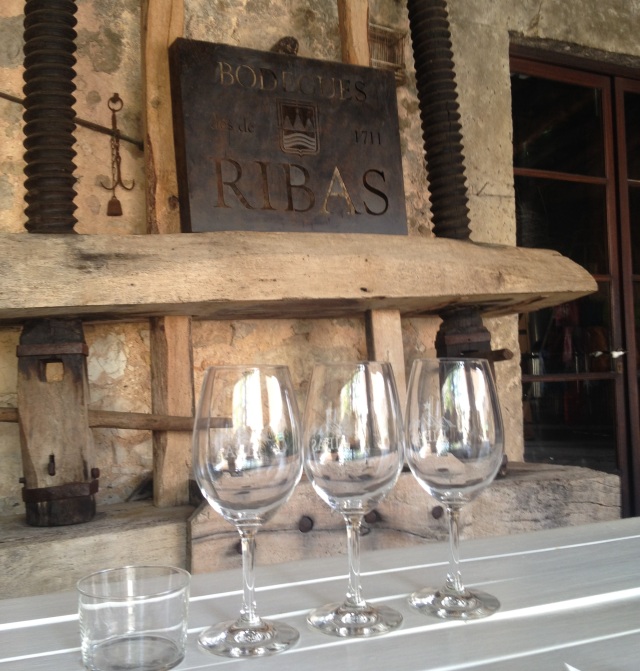“Passion and dedication in a coupage of creativity and unforgettable wines.”

www.bodegaribas.com
+34 971 62 26 73
Consell, Mallorca, Spain
Established in 1711, Bodega Ribas is one of the oldest wineries on the island and has been in the same family for 13 generations; thus it is the oldest one-family winery in Mallorca. After the Phylloxera plague, the family went to olive products, almonds, and carob until they replanted local grapes with American rootstock around the turn of the last century. The current generation, a sister and brother in their late thirties, have completed their oenological degree on the mainland and are the new and highly regarded Ribas winemakers.
Designated organic, Ribas has 40 hectares of vineyards (98 acres) with 160,000 vines planted approximately 2 kilometers from the estate, direction Santa María. Ribas produces 130-150,000 bottles per year. That’s almost 1 bottle per plant, which is generally considered a low yield. However, Ribas’ focus is on quality, and the oldest vines produce less volume, but great flavor. Their local grapes include Manto Negro, Callet, Gorgollassa, and Prensal Blanc. All production is done here at this beautiful historic estate winery.
Experiencing Ribas was like falling in love. Practically in the industrial district of Consell, we followed discreet signs along anonymous inland streets until we turned into the estate, or finca, of Bodega Ribas. We have driven through this town for years, and never realized that there was a bodega here. It is a diamond in the rough. It has been the family home as long as it has been their winery, and it is rare that you get to see one of these inland empires. Clearly, it was once a magnificent country estate – until the town swallowed it up. Our French born tour guide, Sylvia, told us that – incredibly – the family still lived here up until this last decade, and all generations still meet here daily for the family lunch.
We had booked in advance and paid for the full tour and tasting – exciting! Starting the facility and production tour, Sylvia told us that this winery is certified organic, using only natural copper and sulphur dusts to eliminate fungus and pests. August through October they go over every vine by hand as it is less aggressive than machines, includes no branches or snails, allows first selection of early bunches and elimination of weak ones. After that, the grapes are brought in 15kg boxes so no grape is crushed by the weight of others, and then spread onto a table and hand culled before they are put into the de-stemming and maceration machine. It sounded incredibly labor intensive, and yet fantastic that they want to ensure that each wine comes from the best grapes.
They use a pneumatic press, selecting the pressing pressure by grape variety. For red wines they use skin and seed during fermentation/maceration, and then press the grapes after. Rosés are pink (rather than red) because of less time with red-grape skin. Ribas wines are not sold in super markets and are mostly available in restaurants and vinotecas (wine stores). 40% of their product stays here in Mallorca, 10% goes to the mainland, and 50% goes to Switzerland and Germany. Their fermentation area is flanked with stainless tanks, and they add yeast as necessary to complete the processing of sugars in order to achieve the desired flavors and dryness.
During fermentation, skins and seeds rise, so they use a delicate pump to remix. Otherwise those float, known as “the sombrero,” and can mold and the ingredients aren’t available for fermentation. When ready, they lower the temperature to slow or stop fermentation, extract the wine without pressure, press if not already pressed, and go to oak barrel.
Sylvia told us that historically, Mallorcan wineries produced inexpensive wines with no oak barrel aging, no structure, to be ready in three months for the December and January village festivals. Mallorcans in the towns would come to buy “a granel” which is “in bulk,” bringing their own bottles. This is the young wine that towns still provide for the island Saints’ festivals like San Sebastian and San Antoni.
Then we were taken across the estate to the bodega, where they have all the barrels. This is a beautiful, peaceful place. It is an original building and has the thick 1m walls, which helps with the acclimatization. On to the tank room, Sylvia also showed us the 60-year-old cement tanks lined with red non-toxic sealant, historically lined with tile.
These tanks are still used for certain wines and kept at 25-27° Celsius, a temperature slightly higher than the steel tanks can handle without their releasing a steel flavor and aroma. She told us that the Ribas routine is to ferment individual grape types first, and then blend wines as desired (coupage), and age in oak barrels. Over time they taste and sometimes mix further, and finally move the desired wine to bottles for final aging.
Over all, Ribas uses 85% French oak, and 15% American oak barrels, and have them elegantly placed one on top of the other. It is beautiful to see how at Ribas, the modern mixes with the traditional; here the doors are glass and the building centuries old. They are experimenting with different sizes of barrels to see how they affect the wines. We asked Sylvia to explain to us why Ribas and other wineries choose to ferment in oak barrels from multiple countries. She told us that generally speaking, French oak comes from older trees and imparts milder flavors of chocolate and tobacco. American oak barrels come from younger trees (they are dried artificially for timely use), are more porous, and impart robust flavor of coco and vanilla, and they allow more oxygen transference. Who knew???? The year of the barrel is listed on its face (not the year of the wine as we had thought), so the vintners know how long it has been in use, and thus what amount of flavor it is imparting. While still in barrel, they sample the wines to check their evolution, and then top up the barrels as needed; wine evaporates (particularly in porous American oak) and a barrel must stay full to avoid oxidation. [Remember the technique used at Ca’n Pico where the oxygenation was purposeful?] A barrel’s use is a maximum of 12 years (often less). They re-use the barrels 3-4 times then sell them as decorations. They also give them to artists who paint or sculpt them in a project called BotArt that Ribas started. They feel that both winemaking and artistry are creative processes, and this is where they bring the two worlds together in a coupage

Before we went to the tasting room, we were asked if we wanted to see the original house of the familia Ribas. Oh, you bet. We were shown through the home’s “entrada” (or entrance salon), which was set with tables for an event that night; and then into the home’s 1776 kitchen, still intact and fully functional. The Grandparents are the last generation to have lived here, and they still eat here every day with the family in that wonderful Mallorcan tradition. This kitchen is a glimpse back in time to when the island was still largely unchanged for centuries, and we were in awe of its grand and traditional beauty!
Excitingly, the “Cata,” or Wine Tasting came next. The tasting room is beside a courtyard off the fermenting rooms and offices, and we felt like we’d been taken into a secret garden! Here we saw the old barrels that have been transformed into pieces of art, the BotArt Sylvia was telling us about. We always love to see things recycled and repurposed, and creating art out of unneeded wine making ‘equipment’ is an incredible initiative. Eagerly, we sat down amid modern interiors, beside the antique patio with ArtBarrels, and the tasting began.
We are starting to understand that many wineries have lines of wine, and within these lines are selections, generally including white, rosé, and red wines (for example the José Ferrer Winery’s organic line Pedra de Binissalem).
At Ribas their lines are:
- Ribas – 2 whites, 1 red
- Sio – white, rosé, red
Special releases including
- Soma — White, 100% Viognier
- Ribas de Cabrera – Their signature Red Coupage
- Desconfio de la Gente que No Bebe – Red
We were in a heat wave and Sylvia politely pointed out that to keep a chilled white wine cool as long as possible, you hold the glass by the stem to keep the heat of your hand away from it; whereas in the winter you might cup your hand around the glass to help warm and open a red.
As we sipped the marvelous Ribas wines, Sylvia said their red Ribas Negre is very representative of the Mallorcan terroir. School in session: Terroir is the unique flavors and aromas of a wine that come from the growing environment, including soil and climate: In this case from the red Mallorcan earth, rich in salts and limestone. As example, it makes sense that 100% Cabernet Sauvignon wines would present differently (taste and aroma) if produced in the exact same way but with grapes from different terroir.
On the tasting table were six glasses – one for each wine to taste, and crackers, cheese, and Ribas olive oil. Sylvia started by explaining a little bit about each wine, then poured and left the bottle on the table as we are given time to enjoy the surroundings and talk as she came and went.
We were very inquisitive that day and asking lots of questions. Our enthusiasm, we guess, was noted so much that we were introduced to one of the family members: daughter enologist Araceli Servera Ribas. The first thing Tawnee noticed was her shirt! It was a Pink Floyd copy, but with a wine glass instead of a prism, and their web address on the back. Ingenious! Tawnee proceeded to ask her a question that had been bothering her forever: “I always see people sticking their noses in the wine…and I wanted to know what they were really looking for… exactly how does a person smell a wine? ”
Truth be told, as self-educators, so far we have been stabbing wildly to describe aromas. Here we confided in Araceli that there was nothing consistently, logically, obvious to us like “I detect notes of immature lowland moss and gummy bears;” and yet “experts” are confident, direct and concise. Smiling with beautiful wide eyelids like Shelley Duvall, Araceli slowed us down. She said there is a platform to start from, and in enology education they teach the first detections: Fruity or mineral? If fruity, tropical or forest berries like strawberry, blackberry, or stone fruit like plum? If mineral, which one? Maybe iron, old vine, rain on earth? And do you detect barrel aromas? American vanilla or coconut? French cacao, licorice or tobacco? Many barrel-makers burn the barrels to eliminate resin, the scorch lends sometimes-desirable flavor, so wineries clean and choose according to objective: Do you detect a hint of smoke = new barrel? The function of the barrel is to mature the flavors – like when pasta sauce is better the next day because the flavors have bloomed and mingled. Did we detect the balsamics of a young vine? Menthols? Etc. It isn’t a free-for-all as it seemed to us, it is a narrowing, a detection, and recognition. Tawnee made a simple aroma chart:
Soon the conversation took off excitingly on the subjects of grape selection, her winery recommendations, and island wine history. Somewhere in all of this she told us that many red wines in Mallorca are 14% alcohol like a sweet white; because of the amount of sun the island gets, the red grapes get very sweet, and thus it takes a long fermentation period as the yeasts consume the strong sugars before achieving a dry red. We also learned that the Ribas winery is also partly responsible for recovering other indigenous grape varieties of the island, as Gorgollassa and Escursac, which were practically non-existent after Phylloxera. Voracious and exuberant, we moved on to the topic of tannins, which before Araceli had pretty much eluded us as well. Tannins are astringent: they are color stabilizers in wine just as in the leather industry, and lend structure or balance to flavorful wines. Young grape skins and seeds are more astringent, as is new oak; they have bitter macro tannins. Flabby structure in a wine means no tannins, or overly soft tannins (hmmm, we’ve had those wines…). Old vines, like old wood barrels, impart smoother tannins, mellower perhaps, but not considered weak.
Everything was coming clearer. Sylvia poured, we breathed in aromas and washed flavors around our mouths… and we continued to converse with Araceli about her family, the bodega, and why she decided to become an enologist. We could see the passion she holds about wine and doing things right – she has been all over the world in her studies learning about how different wineries make their wine. What we enjoyed the most was that she took the time to hang out with us and help us learn. She was willing and positive, offering ideas and answering questions with patience. We didn’t feel stupid asking the silly things we had always wanted to know. To top things off – she then told us that the shirt she was wearing was for sale there! We both bought one!
A diamond in the rough,
overflowing glasses of good
wine and knowledge.
We sipped on as we talked, so please see our Ribas Tasting Notes for descriptions of the truly gratifying wines we enjoyed here at Bodega Ribas.
Directions:
 On the Highway Palma-Inca take off the exit for Binisalem, Alaro, Consell and at the round about take the ‘left’ or three quarter around turn. That will bring you into the town of Consell. Here you must look for the signs for Bodega Ribas. Follow them (curving through the town) until you reach an estate with an entrance with sign Ribas.
On the Highway Palma-Inca take off the exit for Binisalem, Alaro, Consell and at the round about take the ‘left’ or three quarter around turn. That will bring you into the town of Consell. Here you must look for the signs for Bodega Ribas. Follow them (curving through the town) until you reach an estate with an entrance with sign Ribas.
See Wines Tasted at Ribas: Click Here
### BODEGA RIBAS ###





























